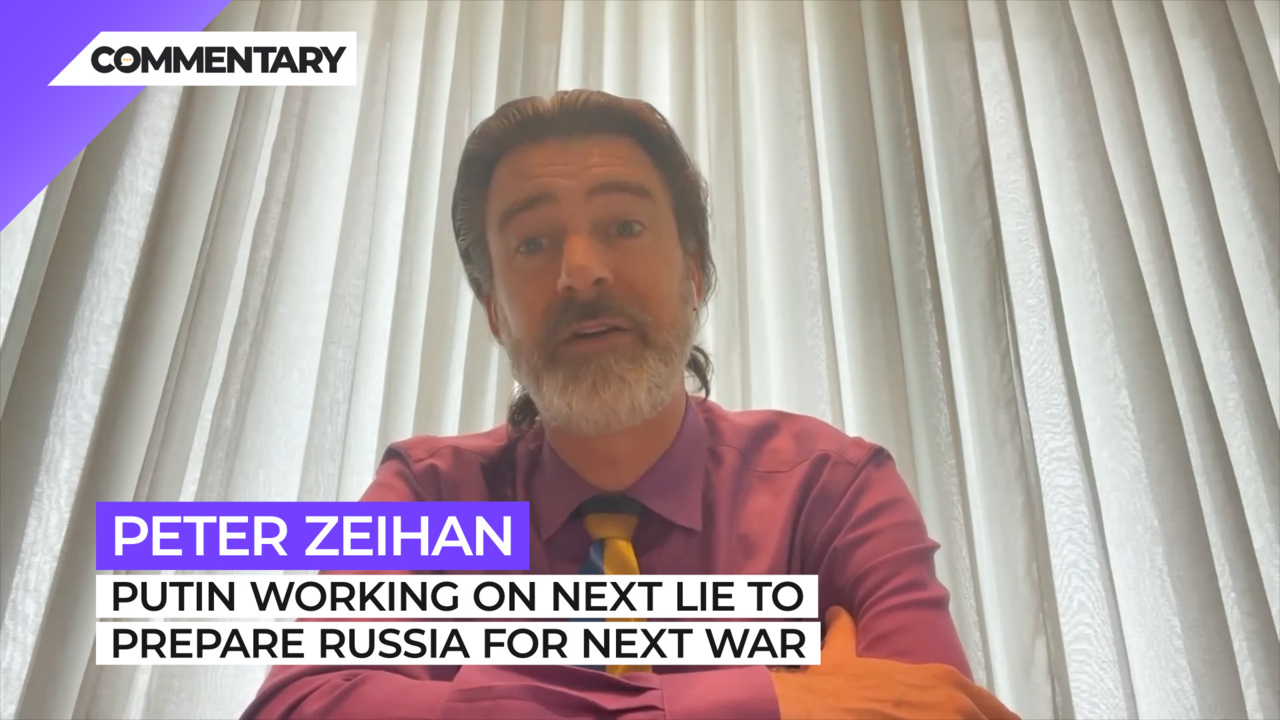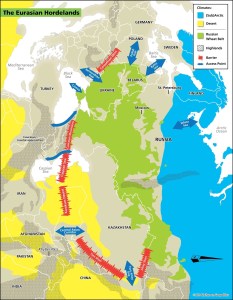
Commentary
-
Our commentary partners will help you reach your own conclusions on complex topics.
Hello, everybody. Peter Zeihan here. It’s time to do a fresh update on the Ukraine war, largely because Vladimir Putin on June 9th gave one of his, um, slightly off the rocker speeches again. And in this one, he was referring to the great Northern war of 1700 to 1721 when Russia was part of a coalition that went to war to break Swedish power in Northern Europe.
At the end of the war, the Russians ended up with chunks of territory that include modern-day Estonia and the bulk of modern-day Latvia. Anyway, in the speech, Putin proclaimed that when this war happened, it wasn’t that Russia was seizing territory; it was that Russia was reclaiming territory that was already Russia’s. Now this is an extraordinarily creative, falsified view of European Russian history, as well as the, the war in general. These territories had never been Russian before, but that’s not the point.
The point is that strongmen when they go on wars of expansion, generally try to justify their tactics in order to generate popular support in a nationalist upwelling. And in that, Putin is not remotely unique at all. So it’s worth looking back, not just at the great Northern war, but at the war we’re in right now in Ukraine to understand what it is that the Russians are actually after, because you’re gonna see more of these speeches moving on and they will give us an idea of where the Russians are prioritizing their offensives.
So the Russian territories in the greater Moscow area, going from Eastern Europe into Western Siberia, they tend to be flat. They tend to be cold. They tend to have short growing seasons. The soil is not particularly fertile and they don’t get reliable rainfall. All that adds up to relatively low output of agricultural stuff per acre, which means that the Russians can’t have a very dense population footprint.
Well, that makes the territory almost impossible to defend because normally, you would try to hunker down between a couple of geographical barriers. They don’t have those, or you would rely on the density of your population to provide a resistance. They don’t have that, either. So Russian strategy from the beginning has been to expand beyond the core Russian territories until they can reach a series of geographic barriers that are difficult for invaders to cross. The Russians then plant static forces in the gateways between these barriers to prevent invaders from hitting them. During the Soviet Union, with which was the height of the Russian people’s security, the Soviet system controlled every single gap leading into the Russian core. Well, when the Soviet union collapsed, they lost all but one of them and everything that the Putin government has been doing with foreign affairs since the year 2000, when he became president, is to try to rebuild that forward position.
Now, this is difficult for a number of reasons. The single biggest one is if you add up the populations of all the countries that control all of the territories between where Russia’s core lands are, and these gaps, you’re talking about of a combined population that is significantly larger than that of Russia itself.
Ukraine is not in control of any of those gaps. But they are on the road to the two biggest ones in Northeastern Romania, known as the Best Arabian Gap and then of course, the Polish gap of Eastern Poland. That’s ultimately where the Russians are trying to get to. And now with this new speech, Putin has made it very clear that the Baltic coast is in play as well because Estonia and most of Lavia were the territories that the Russian seized or in his words, reclaimed in the great Northern war of 1700 to 1721.
So like I said, creative call. But to give you an idea of how seriously the Russians are gonna take this, that seizure of Estonia and Latvia predates Russia’s full assimilation of Kiev by a half of century, and Putin has had absolutely no problem selling his lies on Ukraine to the wider Russian population. So he’s just right now working on the next lie in order to prepare the Russian people for the next war. Okay.
Some, just a couple general updates. First of all, the book comes out tomorrow, June 14th. So the end of the world is almost here. The title is “the end of the world is just the beginning.” It talks about all of the future economic sectors. What they’ll look like once globalization is gone and how everything is going to remake itself on the other side of the slide that it’s already in progress.
If you have found this video or any of our videos or newsletters useful, I strongly suggest that you give a donation to the Afya Foundation, which is providing medical assistance to the Ukrainian refugee community. There are four ways you can help. First of all, all three of our original books, the absent superpower, the accidental superpower, and disunited nations, any sales from any three of those books in any format, all proceeds are going to Afya for now. So if you buy the book, we will make the donation for you. Second if you wanna give a cash donation direct, just go to their website, AFYA foundation.org. It’s pretty self-explanatory process from there.
Third, the AFYA Foundation is great. One of the reasons we chose it is because they have a very low administrative overall overhead, and almost all the donations go specifically to get the equipment to where it needs to go. And the bulk of that equipment is donated from hospital surplus or expired stock. So for any of you who happen to have a hospital connection, we have attached a flyer from AFYA that instructs how folks can get the product to AFYA so that they can then get it onto Ukraine. Uh, it’s a great program that puts things to work that would normally just end up in the trash. And then fourth. And finally, Amazon has worked with AFYA to build a wishlist for the equipment that they have not been able to source in specific volumes. So you can just go to the link that is below this video and peruse the list, enter in the number of bits of product, throw it into your cart, just like you’re making a normal purchase and it will go to AFYA automatically. All right, that’s it for me until next time.
-
Is the US looking for a war?
With conflicts, skirmishes and tensions simmering around the globe, and with the United States playing supporting roles in several of them, the question of whether the country getting involved directly is legitimate. The war in Ukraine, for example, has forced several European countries to reintroduce mandatory military service to confront the growing threat from Moscow.…
-
How future generations could shift US support for Israel
Israeli Prime Minister Benjamin Netanyahu addressed a joint meeting of Congress on July 24, calling for increased bipartisan support for Israel amid its 10-month war with Hamas. He praised President Biden’s “half century of friendship to Israel” and referred to Hamas as “sheer evil.” In the video above, Straight Arrow News contributor Peter Zeihan analyzes…
-
Why election of European Commission president is so important
Ursula von der Leyen has been reelected to another five-year term as president of the European Commission after a vote by EU lawmakers. Von der Leyen will now preside over a coalition that shifted to the right after recent European elections, where ultra-conservative parties won a record number of seats. In July, von der Leyen…
-
Protests in Bangladesh signal more trouble ahead
Public protests in Bangladesh against government hiring practices — and against the government’s military response to those protests — have left at least 174 dead and 2,500 jailed. Bangladesh’s people face an acute jobs and unemployment crisis, so public disagreements over hiring practices carry significant weight. The regime recently enforced a nationwide internet blackout as…
-
In US election, early polling doesn’t tell us anything yet
From President Joe Biden’s declining health to the attempted assassination of Donald Trump, there’s been a series of major political developments in the United States that might impact the results of the November election. These developments have led to renewed confusion, concern and debate regarding which candidate might win, and in the Democrats’ case, which…
Latest Stories
-
 U.S. Department of Defense
U.S. Department of Defense
Congress still trying to figure out how to reduce wasteful military spending
-
 DVIDS
DVIDS
US Navy, Air Force making waves with new weapons at RIMPAC
-
 Getty Images
Getty Images
Israeli PM Netanyahu meets with Trump at Mar-a-Lago
-
 Getty Images
Getty Images
Growing US nuclear power resurgence reaches the nation’s heartland
-
 Getty Images
Getty Images
Beer from the sun, other solar thermal projects get government funding
Popular Opinions
-
In addition to the facts, we believe it’s vital to hear perspectives from all sides of the political spectrum.
Latest Opinions
In addition to the facts, we believe it’s vital to hear perspectives from all sides of the political spectrum. We hope these different voices will help you reach your own conclusions.
The opinions published in this section are solely those of the contributors and do not reflect the views of Straight Arrow News.


















Latest Commentary
We know it is important to hear from a diverse range of observers on the complex topics we face and believe our commentary partners will help you reach your own conclusions.
The commentaries published in this section are solely those of the contributors and do not reflect the views of Straight Arrow News.
Peter Zeihan
Geopolitical StrategistHow future generations could shift US support for Israel
Why election of European Commission president is so important
Protests in Bangladesh signal more trouble ahead
Dr. Frank Luntz
Pollster and Political Analyst‘I don’t know’: Swing voters debate who best to replace Biden
‘Mad as hell’: Americans vent anger, frustration over politics
‘On death’s door’: Undecided voters react to first debate